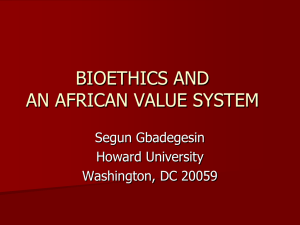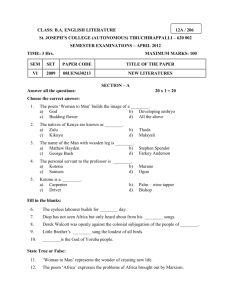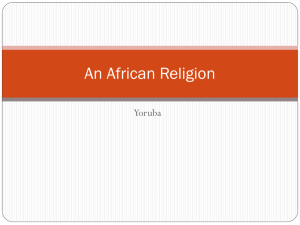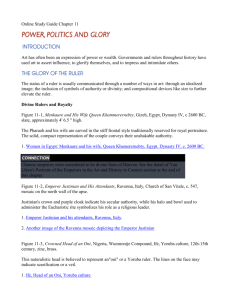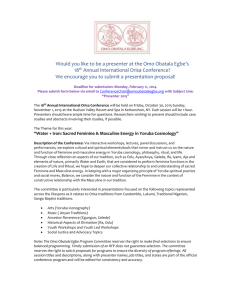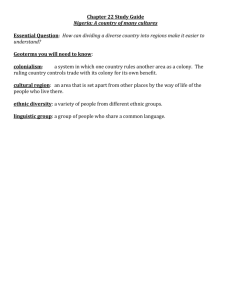Language Use in a Yoruba-Speech Community.
advertisement
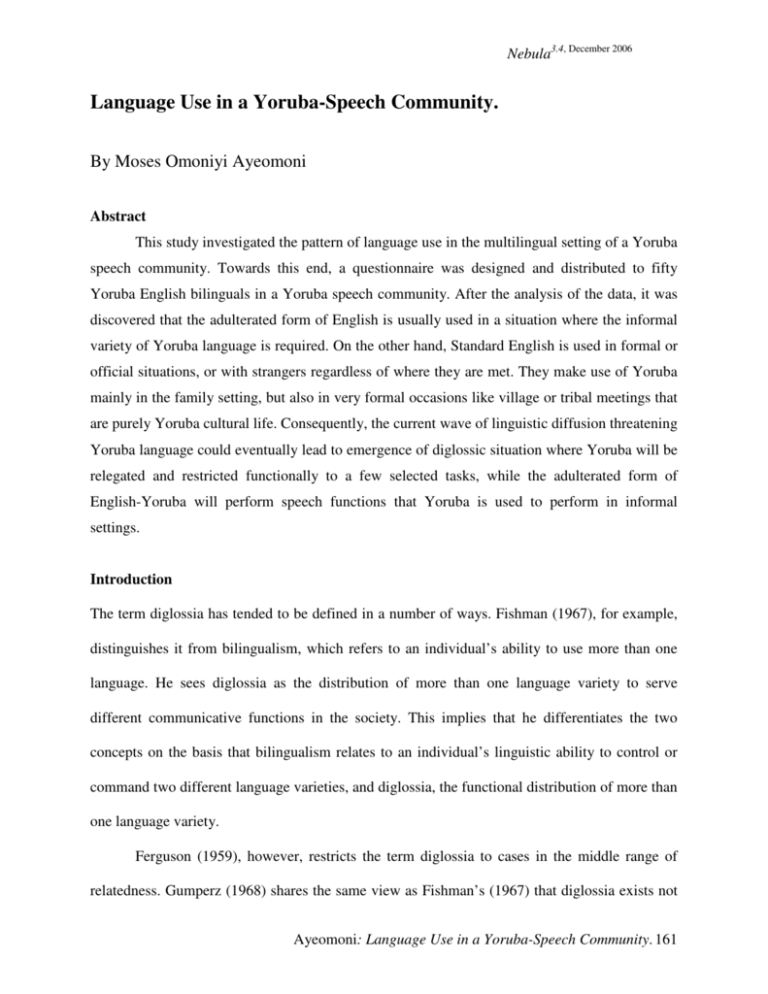
Nebula3.4, December 2006 Language Use in a Yoruba-Speech Community. By Moses Omoniyi Ayeomoni Abstract This study investigated the pattern of language use in the multilingual setting of a Yoruba speech community. Towards this end, a questionnaire was designed and distributed to fifty Yoruba English bilinguals in a Yoruba speech community. After the analysis of the data, it was discovered that the adulterated form of English is usually used in a situation where the informal variety of Yoruba language is required. On the other hand, Standard English is used in formal or official situations, or with strangers regardless of where they are met. They make use of Yoruba mainly in the family setting, but also in very formal occasions like village or tribal meetings that are purely Yoruba cultural life. Consequently, the current wave of linguistic diffusion threatening Yoruba language could eventually lead to emergence of diglossic situation where Yoruba will be relegated and restricted functionally to a few selected tasks, while the adulterated form of English-Yoruba will perform speech functions that Yoruba is used to perform in informal settings. Introduction The term diglossia has tended to be defined in a number of ways. Fishman (1967), for example, distinguishes it from bilingualism, which refers to an individual’s ability to use more than one language. He sees diglossia as the distribution of more than one language variety to serve different communicative functions in the society. This implies that he differentiates the two concepts on the basis that bilingualism relates to an individual’s linguistic ability to control or command two different language varieties, and diglossia, the functional distribution of more than one language variety. Ferguson (1959), however, restricts the term diglossia to cases in the middle range of relatedness. Gumperz (1968) shares the same view as Fishman’s (1967) that diglossia exists not Ayeomoni: Language Use in a Yoruba-Speech Community. 161 Nebula3.4, December 2006 only in multilingual society which officially recognizes several languages, but also in societies that employ several dialects, registers, and functionally differentiated varieties of whatever kind. Gumperz (ibid) focuses on the study of language diversity, and Fishman’s use of the term refers to any degree of diversity right from the most subtle stylistic differences from or within the same simple language to the most complex form of diversity like two totally unrelated languages so that we can be talking about multilingual and bilingual diversities. Fishman further claims that the criterion for identifying diglossia is the degree of individual bilingualism found in a society, in such a way that the linguistic differences must be functionally distinguished within the society. Based on the foregoing, diglossia could be used to refer to the functional distribution of High and Low varieties of a language within the society. It is on the basis of this definition that Ferguson (1959) observes that there are four types of diglossic relationships: 1. A situation of diglossia and bilingualism 2. A situation of diglossia without bilingualism. 3. A situation of bilingualism without diglossia. 4. A situation of no diglossia and bilingualism Fishman (ibid) discloses that it is difficult to find the kind of community described in (4) because in this situation, there is only one linguistic variety that exists, and no differentiation of any form either functional, stylistic or dialectal. Ferguson (ibid) goes ahead to show a distinction between diglossia and the relationship that exists between standard language and regional dialects. Fishman, however, is silent over the issue of regional dialects. He bases his own concept of diglossia on the totality of existing languages. However, both of them (Fishman and Ferguson) recognize the functional distribution Ayeomoni: Language Use in a Yoruba-Speech Community. 162 Nebula3.4, December 2006 of varieties of two languages on the bases of H and L varieties. Fasold (1984) raises the question of functional issue by trying to verify and identify the exact nature of the social function which H and L varieties are associated with. This question raised by Fasold has an answer in the view of Fishman and Ferguson since the two of them jointly agree that there is functional distribution of two varieties or two languages in the society, suggesting that they both agree on the existence of H and L varieties. They both view that the H-V is used for formal purposes while the L-V is reserved for less formal purposes. Fasold, (ibid) however, still raises other questions. These include: i. What happens in a multilingual setting where more than two languages exist? ii. What is the extent of relatedness of the language? iii. What is the relationship between standard language and dialects? It is commonly assumed that language often develops varieties used to carry out different functions language is meant to perform; it is also an assumption that a bilingual in a speech community usually shares the same pairs of language which often results in the evolution or development of a new system of communication by means of hybridization of the hybridized or the newly evolved mode of communication in Yoruba speech community that I refer to as “Yoruglish” Ayeomoni (1990, 2004). Milroy (1980), for instance, describes the situation in which an indigenous vernacular like Yoruba is mixed with English as a kind of personal vernacular. On the other hand, Beardsmore (1982) refers to it as an inter-language which Yoruba-English bilinguals usually use in spontaneous speech and in conversation for intra-group interactions. Ayeomoni: Language Use in a Yoruba-Speech Community. 163 Nebula3.4, December 2006 Language Use in a Multilingual Setting The present study was designed to find out what happens to the pattern of language use in a multilingual setting like a larger Yoruba speech community. For this purpose, a questionnaire was designed and distributed to fifty Yoruba-English bilinguals within Ondo township, one of the Yoruba speech communities. The selected respondents have qualifications equivalent to the first University degree, and they are mainly civil servants within the town. They make use of both English and Yoruba languages everyday. The ratio of male to female respondents was put at 3:2, and this is due to the fact that there are more male graduate civil servants than female graduate civil servants in the particular area in which this study was conducted. Most of the questions in the questionnaire were designed to find out from the respondents the kind of languages spoken or used at different periods, occasions and the various functions the languages were meant to perform vis-à-vis the factors motivating the chosen codes at a particular period. The analysis of information gathered from the questionnaire was undertaken by means of a simple statistical method. In doing this, the investigator ensured that the questionnaire was properly filled out by the respondents. An attempt was also made to get recoded spontaneous conversations of Yoruba – English bilinguals. The information was transcribed using simple orthographic conventions. After transcription, the results obtained were compared and correlated with the already analyzed respondents from the questionnaire in order to show how the respondents use all the languages they control and the purposes and functions to which the languages are put. The findings are discussed in the following sections. Ayeomoni: Language Use in a Yoruba-Speech Community. 164 Nebula3.4, December 2006 Language Use in Informal Setting The focus here was to find out the language used by the respondents in informal situations like home, club house, market, restaurants, motor part, etc. In the home, as expected, the language mainly used is Yoruba. 80% of the respondents indicated that they used Yoruba mainly at home with their nuclear family, while 20% of the respondents indicated that they used English to communicate with their nuclear family. This means English performs a subordinate linguistic function in the home. The situation however differs when non-family members are present in the family or in other informal settings outside the family circle. In this context, most of the respondents indicated that they would use English to talk to the stranger. This finding implies the following: • The type of social relation existing among members of nuclear family is strong as to instantly determine code-choice and language use. • The educated Yoruba-English bilinguals are also members of other social networks other than the family which also determines or influences the choice of other codes. • Language use and code-choice co-vary with social networks and each network imposes a norm on its members about language and codes to use. • The choice and use of a particular variety of a language in a social context could be an unconscious one or a determined choice, and the extent to which an individual can appropriately do this, is a measure of what Hymes (1974, 75) refers to as a person’s “Communicative competence”. The dominance of English in the adult life of the educated Yoruba bilingual accounts for his use of English even in formal situations, regardless of the fact that he has spent the greater Ayeomoni: Language Use in a Yoruba-Speech Community. 165 Nebula3.4, December 2006 part of his life in Yoruba speech community. It is the high level of educational attainment vis-àvis the social network structure that has conditioned his language habits (especially in English Language use). Language Use in Formal Settings The finding suggests that the educated Yoruba bilinguals use Yoruba mainly with members of his family, and when he runs into non-family members who are either intimate friends or mere acquaintances, Yoruba and English are used in equal proportions regardless of the meeting place or social set-up. However, if the meeting place is home, Yoruba is preferred. The following deductions could be offered: • The educated Yoruba-English bilingual speaks Yoruba as his LI; he has competence in the use of the language. However, the acquisition of formal education, job experience and social interaction of all sorts have equally made him to acquire higher communicative competence in the use of English. This is attested to by the fact that he often uses English in situations where the use of his first language will be appropriate. • In his bid to acquire education and to gather work experience in various urban centres, he is then automatically removed from his Yoruba cultural setting where only Yoruba is spoken. This then exposes him to various social networks in which the use of English to him becomes inevitable. • The nature of some of the networks to which these educated Yoruba-English bilinguals find themselves is such that the topics for discussion are not within the Yoruba cultural life of experience, and the only language of interaction shared by every member of the group is English. Ayeomoni: Language Use in a Yoruba-Speech Community. 166 Nebula3.4, December 2006 Literacy and Code-Usage It is discovered from the data that there is a gradual increase in the level of code-mixing of Yoruba bilinguals’ speech as they progressively move up in the academic ladder. Those with little or no education use mainly loaned words that consist of single lexical items. The grammatical class of such words or lexical items is always a noun. Examples are Motor, Fan, Electric, Table, Beer, Hotel Pail, College, University, Television, Fridge, Football, Field, School and so on. Their phonological shapes have already been adapted and assimilated into Yoruba phonological structure. In a situation where such loans have local alternative names, there is always a vacillation between the use of the foreign and local words. The younger people with good education prefer the foreign words, while the older monolinguals prefer the local or the Yoruba alternative as in: English Motor Yoruba Oko Bed Mirror Ibusun Jigi Cup Ife Plate Awo Table Tabili Field Papa Biro Kalamu The predominance of single lexical items and of a certain category of words could be indicative of cognitive processes involved in incipient bilingualism. It could also help to show that efficient switching of codes in the two languages involved a possession of a grammar that is a fusion of the grammars of the two linguistic codes. Ayeomoni: Language Use in a Yoruba-Speech Community. 167 Nebula3.4, December 2006 At a higher level of education, the phenomenon of code switching in English and Yoruba is observed to be restricted to the major constituents of a sentence. Such as word groups of two or three lexical items like a noun phrase (NP), verb phrase (VP) or an adjectival complement. Similarly, in a local setting during the giving away of a young girl in marriage, Yoruba language is often selected and exclusively used for performing certain communicative functions, such as prayers with cola, presentation and exchange of gifts, giving or offering words or advice to the suitor, bride and so on. But now with a rise in the level of literacy, it is likely that more and more people would be getting involved in code-mixing use in Yoruba speech community which will consequently lead to the emergence of inter-language that will override the original form of Yoruba to the extent that Yoruba as it was originally spoken would eventually recede to a position of diglossic function as a language of purely cultural and religious purposes. Conclusion and Prospects An interesting finding of this study is that the adulterated form of English is usually used in a situation where the informal variety of Yoruba language would have been used if the respondents had been Yoruba monolinguals. These situations are mainly informal in type. In an occasion like this, the language use of our subjects is neither English nor Yoruba. The name I give to this language is ‘Yoruglish’; its grammar has the surface features of blending of Yoruba and English syntactic components. On the other hand, our subjects make use of Standard English in very formal or official situations, or with strangers, even though the stranger is met in informal settings. They also make use of Yoruba mainly in the family setting, but also in very formal occasions like village or tribal Ayeomoni: Language Use in a Yoruba-Speech Community. 168 Nebula3.4, December 2006 meetings and during church prayers. Yoruba is also used during events or activities that are purely Yoruba cultural life such as naming ceremonies, traditional marriages, burials or funerals. These research findings will help in the areas of language and culture to create the awareness that the Yoruba language as it is now spoken in rural areas is threatened with linguistic diffusion, and if this happens, it means in effect that the death of at least parts of the values and culture which Yoruba is used to express is imminent. This can then consequently lead to the emergence of a diglossic situation where Yoruba will be gradually relegated and restricted functionally to a few selected tasks such as religious sacrifices, child-naming ceremonies, burials, incantations and traditional marriage speech making. On the other hand, the just evolved “Yoruglish” will perform speech functions that Yoruba is used to perform today in informal village settings. This is made obvious by the fact that more and more people are ascending the educational ladder, and the phenomenon of code-mixing is spreading to the nooks and crannies of our villages. Moreover, more and more rural areas are becoming urbanized. If this type of linguistic situation is developed fully, it would eventually lead to the emergence of ‘polyglossia’ in the larger Yoruba speech community. References Adekunle, M. (1974). “The standard Nigerian English” in Sociolinguistic Perspective. JNESA, 6(1), 24-37. Adetugbo A. (1980). “The English Language in the Nigerian Experience”. An inaugural lecture delivered at the University of Lagos, 128. Ayeomoni: Language Use in a Yoruba-Speech Community. 169 Nebula3.4, December 2006 Akere, F. (1982), “Sociolinguistic Constraints and the emergence of a standard Nigerian English”. In New Englishes Ed. J. B. Pride, Rowley Mass. Ayeomoni, M. O. (1990) “Code switching and code mixing: style of Language use in Yoruba Speech Community: A situation of Bilingualism”, M.A. Dissertation of the University of Lagos. _______________ (2004) “Code Switching and Code mixing: Style of Language Use in Yoruba Speech Community”, In Unizik Journal of Arts and Humanities, Awka, Vol. VI, 179-186. Beardsmore, B. H. (1982), Bilingualism: Basic Principles. Avon, England, Multilingual Matters Ltd Fasold, R. (1984), The Sociolinguistics of Society. New York, Blackwell Ferguson, C. A. (1959) “Diglossia” in Language in Social Context. (ed.) Pier Paolo Giglioli. Middlesex, England, Penguin, 232-257. Fishman, J. (1967). “Bilingualism with and without diglossia: Diglossia with and without bilingualism.” Journal of Social Issues, 23(2), 29-38. ____________ (1968). Readings in the Sociology of Language. The Hague: Mouton and Co. Gumperz, J. J. (1968), “The Speech Community” in Language in Social Context (ed.) Gilglioli. 219-239. Hudson, R. A. (1980). Sociolinguistics. Cambridge Press. Ayeomoni: Language Use in a Yoruba-Speech Community. 170 Nebula3.4, December 2006 Hymes, D. H. (1974) Foundations in Sociolinguistics: An Ethnographic Approach. London: Taristock Publications. Milroy, L (1980) Language and Social Networks, London: Nasil Blackwell. APPENDIX I QUESTIONNAIRE Instruction: Please, kindly fill this questionnaire completely by ticking the space you select for each number. Where the information demanded does not apply to you, leave the spaces for the number blank (i.e. unticked). 1. Sex: 2. Please to which of the age-groups do you belong? 3. 4. 5. Male…………………….. Female…………………… 1-20…………….. 21-30……………………… 31-40……………. Over 40………………….. What language(s) do you often speak? Yoruba……………………… English………………….. Pidgin………………………. Others…………………… What language did you first learn to speak before school age? Yoruba……………………… English………………….. Pidgin………………………. Others…………………… In what language do you normally use to communicate with your nuclear family (wife and children)? 6. Yoruba……………………… English………………….. Pidgin………………………. Others…………………… What language do you normally interact with other members of your immediate family (father, mother, brothers, sisters)? 7. Yoruba……………………… English………………….. Pidgin………………………. Others…………………… What do you use to reach non-members of your close family (uncle, cousin, nephew, aunt)? Ayeomoni: Language Use in a Yoruba-Speech Community. 171 Nebula3.4, December 2006 8. 9. In what language do you interact with your colleagues (friends)? Yoruba……………………… English………………….. Pidgin………………………. Others…………………… What language would you normally use if a colleague visits you in your place of work or if you visit such a colleagues in his/her? 10. Yoruba……………………… English………………….. Pidgin………………………. Others…………………… What language would you use in speaking to a non-colleagues or a person not familiar with you, if you visit or happen to come across such a person? (a) (b) (c) In his office or place of work? Yoruba……………………… English………………….. Pidgin………………………. Others…………………… In his Home Yoruba……………………… English………………….. Pidgin………………………. Others…………………… In an informal setting (like a party, club house restaurant, market, football field, etc)? Yoruba……………………… English………………….. Pidgin………………………. Others…………………… Ayeomoni: Language Use in a Yoruba-Speech Community. 172
